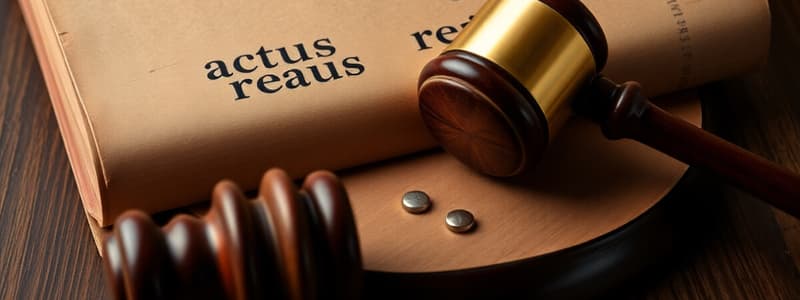Podcast
Questions and Answers
According to the principles of criminal law, which element signifies the 'forbidden situation' that constitutes a crime?
According to the principles of criminal law, which element signifies the 'forbidden situation' that constitutes a crime?
- Motive
- Causation
- Mens Rea
- Actus Reus (correct)
In criminal law, what are the three forms that Actus Reus can take?
In criminal law, what are the three forms that Actus Reus can take?
- Acts, omissions, and states of affairs (correct)
- Omissions, negligence, and motive
- Intent, negligence, and recklessness
- Acts, intent, and motive
In the context of criminal law, what does the Latin phrase 'Actus non facit reum nisi mens sit rea' generally translate to?
In the context of criminal law, what does the Latin phrase 'Actus non facit reum nisi mens sit rea' generally translate to?
- Ignorance of the law is no excuse
- The law excuses an act committed under duress
- An act is not criminal unless proven with evidence
- An act does not make a person guilty unless the mind is also guilty (correct)
Which of the following scenarios would most likely be considered an example of Actus Reus through omission?
Which of the following scenarios would most likely be considered an example of Actus Reus through omission?
Which of the following is the most accurate definition of Mens Rea?
Which of the following is the most accurate definition of Mens Rea?
In the case of Hogg v MacPherson (1928), what principle concerning Actus Reus was emphasized?
In the case of Hogg v MacPherson (1928), what principle concerning Actus Reus was emphasized?
In the case of R v White [1910], what essential element of criminal liability was found to be missing?
In the case of R v White [1910], what essential element of criminal liability was found to be missing?
According to the general rule established in HM Advocate v Kerr and Others (1871), under what circumstances is there typically no liability?
According to the general rule established in HM Advocate v Kerr and Others (1871), under what circumstances is there typically no liability?
What exceptions apply to the general rule that there is no liability for omissions?
What exceptions apply to the general rule that there is no liability for omissions?
In criminal law, what is meant by the term 'states of affairs' in the context of Actus Reus?
In criminal law, what is meant by the term 'states of affairs' in the context of Actus Reus?
In the case of Quinn v Lees (1994), what aspect of criminal liability was discussed?
In the case of Quinn v Lees (1994), what aspect of criminal liability was discussed?
What key mental element was at issue in the case of Paton v HM Advocate (1936)?
What key mental element was at issue in the case of Paton v HM Advocate (1936)?
Which of the following best characterizes the principle established in Thabo Meli v R [1954]?
Which of the following best characterizes the principle established in Thabo Meli v R [1954]?
What legal concept was central to the court's decision in Roberts v Hamilton (1989)?
What legal concept was central to the court's decision in Roberts v Hamilton (1989)?
Proving a causal link is most critical in establishing liability for which of the following crimes?
Proving a causal link is most critical in establishing liability for which of the following crimes?
In the context of causation, what principle was established in HM Advocate v Robertson and Donoghue (1945)?
In the context of causation, what principle was established in HM Advocate v Robertson and Donoghue (1945)?
What factor did the court consider in McDonald v H.M. Advocate (2007) when evaluating causation?
What factor did the court consider in McDonald v H.M. Advocate (2007) when evaluating causation?
According to the general rule articulated in HM Advocate v Kerr and Others (1871) regarding Art and Part Liability, what are individuals liable for?
According to the general rule articulated in HM Advocate v Kerr and Others (1871) regarding Art and Part Liability, what are individuals liable for?
In the context of Art and Part Liability, what principle was established in HM Advocate v Fraser & Rollins (1920)?
In the context of Art and Part Liability, what principle was established in HM Advocate v Fraser & Rollins (1920)?
Which concept is associated with the case of Boyne v HM Advocate (1980) in relation to Art and Part Liability?
Which concept is associated with the case of Boyne v HM Advocate (1980) in relation to Art and Part Liability?
What distinguishes the preparation of a crime from the actual perpetration, as highlighted in HM Advocate v Camerons (1911)?
What distinguishes the preparation of a crime from the actual perpetration, as highlighted in HM Advocate v Camerons (1911)?
What is the focus of the case Docherty v Brown (1996) with respect to attempted crimes?
What is the focus of the case Docherty v Brown (1996) with respect to attempted crimes?
What constitutes the crime of conspiracy?
What constitutes the crime of conspiracy?
In the context of conspiracy, as illustrated in West v HM Advocate (1985), what factor was considered?
In the context of conspiracy, as illustrated in West v HM Advocate (1985), what factor was considered?
What is the essence of the crime of incitement?
What is the essence of the crime of incitement?
Flashcards
Actus Reus
Actus Reus
The forbidden situation, encompassing acts, omissions, and states of affairs.
Actus non facit reum nisi mens sit rea
Actus non facit reum nisi mens sit rea
A legal principle: an act does not make a person guilty unless the mind is also guilty.
Omissions Liability
Omissions Liability
General rule: there is no liability for omissions unless exceptions apply.
Mens Rea
Mens Rea
Signup and view all the flashcards
Causal Link
Causal Link
Signup and view all the flashcards
Art and Part Liability
Art and Part Liability
Signup and view all the flashcards
Conspiracy
Conspiracy
Signup and view all the flashcards
Incitement
Incitement
Signup and view all the flashcards
Study Notes
- Foundations of Criminal Law
Actus non facit reum nisi mens sit rea
- Legal principle requiring both a guilty act (actus reus) and a guilty mind (mens rea) to establish criminal liability.
Actus Reus: The Forbidden Situation
- Encompasses the external elements of a crime including acts, omissions, and states of affairs.
Acts
- Voluntary acts are a key element in establishing actus reus
- Hogg v MacPherson 1928 JC 15: It was determined there was no voluntary act
- R v White [1910] 2 KB 124, CA: It was determined there was no causal link
Omissions
- Generally, there is no liability for omissions
- HM Advocate v Kerr and Others (1871) 2 Couper 334: This established the general rule of no liability for omissions
- Exceptions to the rule can arise by statute, contract/employment, family relationships or creating a dangerous situation.
States of Affairs
- Specific circumstances that can constitute actus reus.
Mens Rea: The Mental Element
- Refers to the mental state of the accused at the time of committing the act
Subjective or Objective
- The assessment of mens rea can be subjective, focusing on the actual state of mind or objective, considering what a reasonable person would have thought or done
Motive
- Motive is generally not a consideration
- Quinn v Lees 1994 SCCR 159: It was determined the motive was a joke
Intent, Recklessness, Negligence
- Different levels of mens rea, reflecting varying degrees of culpability
- Paton v HM Advocate 1936 JC 19: recklessness
The Interaction of Actus Reus and Mens Rea
- Refers to the relationship of having both a guilty act and a guilty mind
- Thabo Meli v R [1954] 1 WLR 228: Conduct was treated as a continuous act
- Roberts v Hamilton 1989 JC 91; 1989 SLT 399: transferred intent
Causation
- Establishing a causal link between the accused's actions or omissions and the resulting harm is crucial in many crimes
Crimes that require Causation
- Fraud
- Aggravated Assault (but not 'simple' assault)
- Murder and Culpable Homicide
Causation - and Breaking the Causal Chain
- The causal chain can be broken by certain intervening events
- HM Advocate v Robertson and Donoghue (1945, unreported): take victim as you find him/her
- R v White [1910] 2 KB 124, CA: no causal link
- McDonald v H.M. Advocate 2007 SCCR 10: victim's contribution can break chain of causation
- Malregimen: bad medical treatment can also disrupt causation
Art and Part Liability
- Relates to the liability of individuals who participate together in committing a crime
- HM Advocate v Kerr and Others (1871) 2 Couper 334: general rule: liable for own acts and omissions
- HM Advocate v Fraser & Rollins 1920 JC 60: each accused is liable for the ultimate actus reus
- HM Advocate v Gallacher 1951JC 38: spontaneous coming together
- Boyne v HM Advocate 1980 SLT 56: step outside the common plan
Attempted Crimes
- Focuses on situations where an accused attempts a crime but does not complete it
- HM Advocate v Camerons (1911) 6 Adam 456: preparation to perpetration of a crime, the pearl necklace case
- Docherty v Brown 1996 JC 48; 1996 SLT 325: deals with impossible attempts
Acts towards committing the crime requirements
- "the mere intention to commit a crime is not criminal - some act is required, and we do not think that acts towards committing the crime are indictable. Acts remotely leading to the crime are not considered to be attempts, but acts immediately connected with it are."
Conspiracy
- An agreement between two or more persons to commit a crime or crimes intending to carry out that crime(s)
- Where a specific crime(s) has been carried out in pursuance of a conspiracy
- Where no other specific crime is charged
- Where a charge of conspiracy is a substitute for a charge of "attempt"
- West v HM Advocate 1985 SCCR 248: loitering suspiciously with weapons
Incitement
- Inviting another to enter a conspiracy or commit a crime, with the intention that the other will carry out that crime
- Baxter v HM Advocate 1997 SCCR 437: it is enough that the accused is serious
Studying That Suits You
Use AI to generate personalized quizzes and flashcards to suit your learning preferences.




